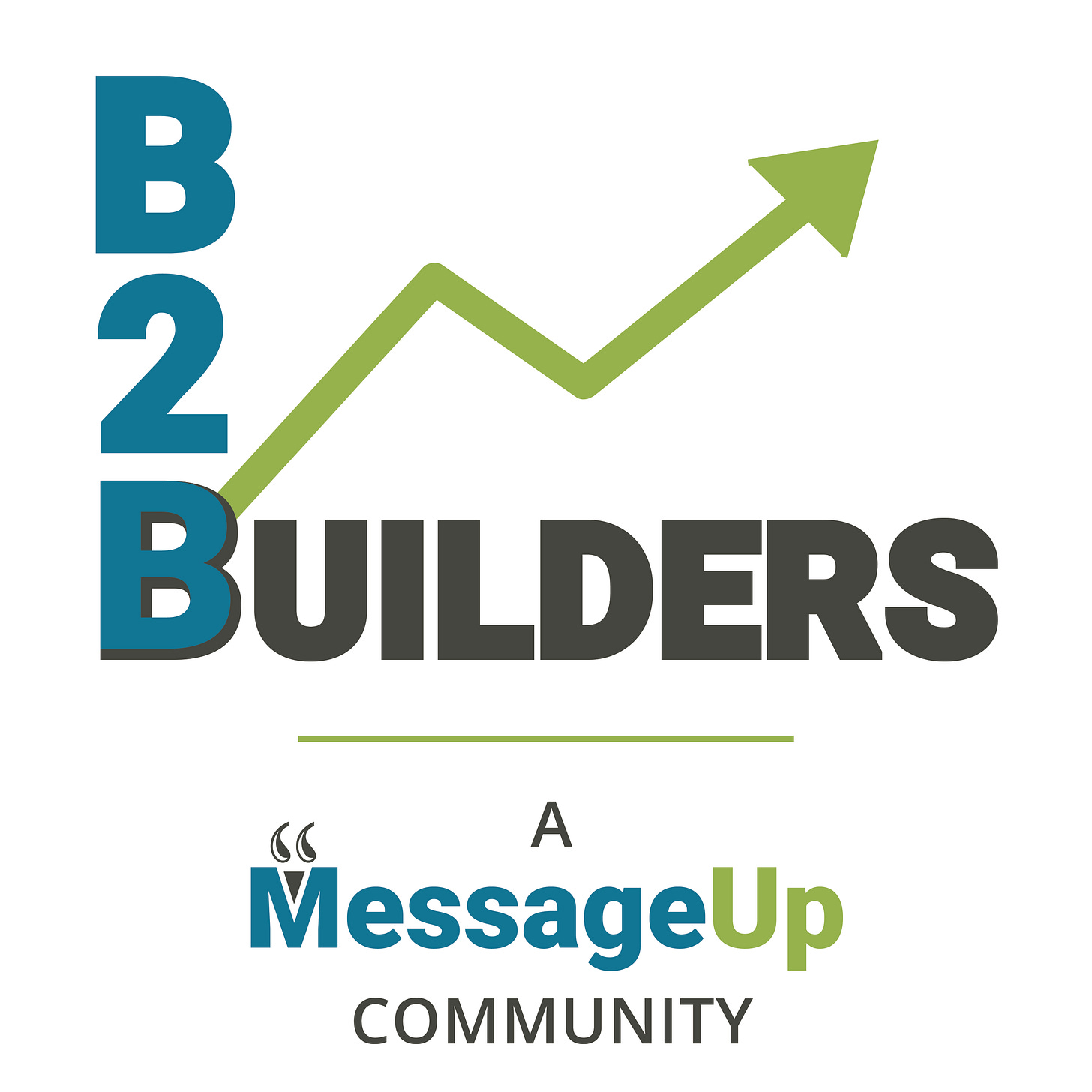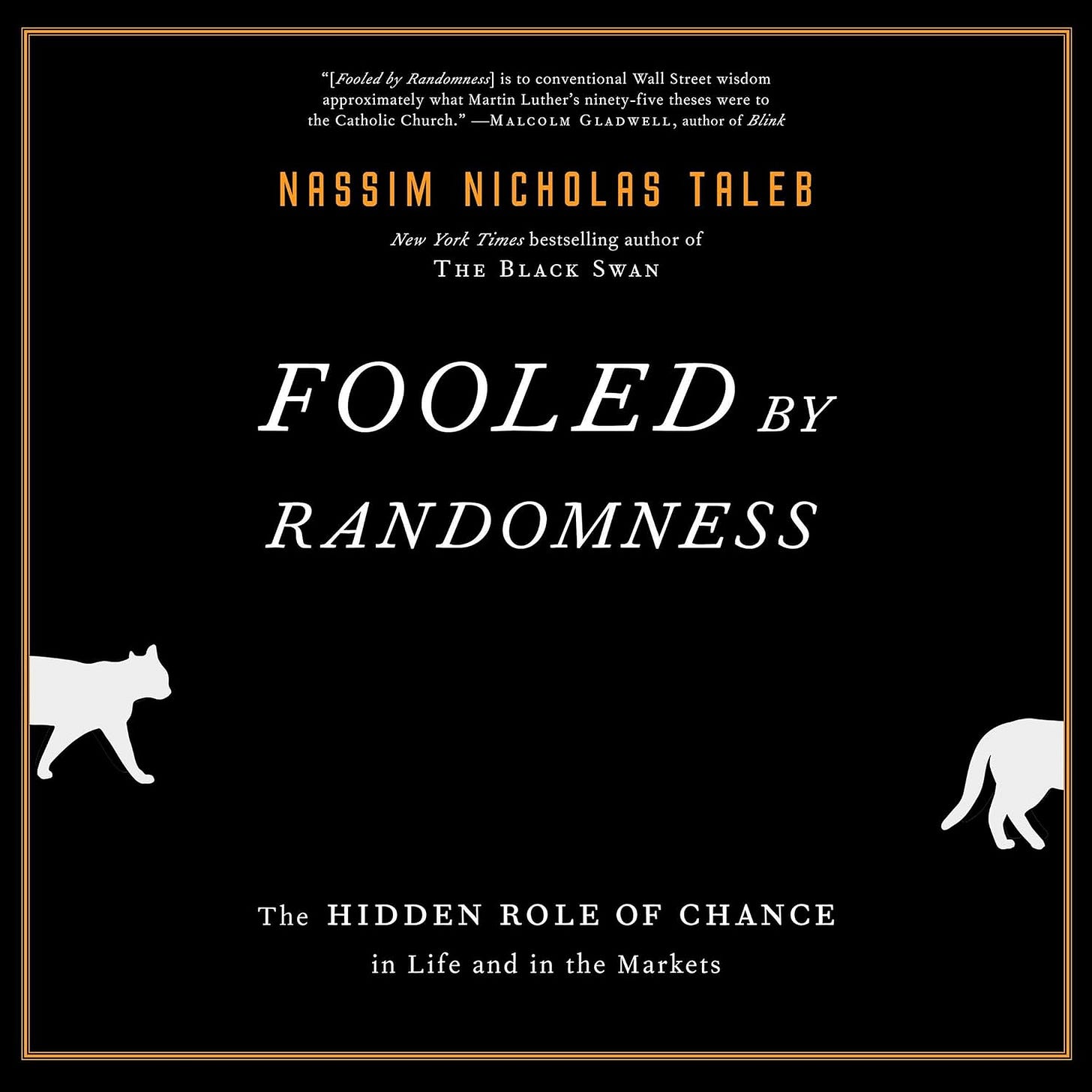Hello there!
Matt here from MessageUp, with the first newsletter in our new monthly format.
In case you missed the announcement in Edition 100, we have decided to dial back the frequency of our Substack publications to focus on other channels. A complicated decision, for sure, but one that we’re confident will maximize the impact we generate in the time we have available to invest.
To see more of our content, follow us on LinkedIn.
In this newsletter, you’ll find:
An update on our B2B Builders community.
A discussion on the merits of basic versus sophisticated marketing, and how the B2B marketing media is biased toward one end of that spectrum.
Summaries of our latest blog posts, the most recent of which discussed extreme content marketing that uses shock value to grab audience members’ attention.
A book review and recommendation.
Two article reviews, one covering the impact on marketing of cutting DEI initiatives, and the other about creating a sonic identity for your brand.
Some closing thoughts on the debate swirling around LinkedIn’s decision to add games to its platform.
Enjoy the read! And, please, let us know what else you’d like to see covered in these pages.
Cheers,
~ Matt
Business Update
We’ve been writing for several months about the imminent launch of our online community. This week, we finally opened the platform to a small group of beta testers—a major milestone!
Some key things to know:
The community is called B2B Builders, capturing as succinctly as possible “who it’s for”.
We’re building our community on the Mighty Networks platform, which gives us some amazing out-of-the-box functionality, including pre-built mobile apps for iOS and Android.
The initial members will be Founders and CEOs, with the potential to extend membership to other leaders once the community becomes more established. This is different from our initial concept, which would have included CMOs (and equivalent) from the start, and is based on feedback from those with whom we have tested the concept.
The private beta will continue for at least a couple of weeks as we expand the Founder Members group and test different functionality. If you are interested in joining while the party is still getting going, complete an online application here.
We will begin hosting live events as early as next week. Our first featured guest will be sharing his expertise on the hot topic of artificial intelligence, dispelling some of the myths and helping members understand where the real near-term value lies in AI applications.
We’re super excited about this addition to the MessageUp portfolio, although we realize it will take time to recruit and onboard enough members for the community to truly take flight.
If we’ve confirmed one thing during this process, it’s that CEOs are busy people who take time to react and respond 😅.
Basic versus Sophisticated B2B Marketing
An introductory level course is sometimes known as “101” in keeping with traditional course-numbering practices at training schools and colleges.
For example, “Marketing 101” would cover the basics of marketing for someone with little or no prior knowledge of the subject.
So, it seems fitting that we should discuss basic marketing in Edition 101 of this newsletter.
However, that’s not what brought us to this topic.
It was the rash of recent articles decrying basic B2B marketing practices.
Numerous marketing gurus have penned pieces on the demise of lead generation, lead scoring, marketing-qualified leads, and lead nurturing.
They’ve poured supportive comments onto each others work in a self-reinforcing frenzy.
Skim-reading your social media feed, you might justifiably conclude that B2B marketing is experiencing an epiphany and leaving its archaic past behind.
But you’d be mistaken.
This is the work of marketers at large, sophisticated B2B corporations, who primarily sell to other, large, sophisticated businesses.
When your buyer has become more sophisticated in their approach, so you must adapt your marketing to continue meeting their needs and expectations.
However, at a majority of B2B businesses—over 90-percent of which are classified as SMB (small and medium sized businesses)—things have not changed much at all.
Yes, buyers are becoming increasingly digital-savvy. Like any segment of the workforce, there is a rapid transition underway from retiring Boomers to digital native Millennials and Gen-Z.
Yes, technology plays an increasing role in solution identification, evaluation, and selection—including some applications of artificial intelligence.
But, no, buying processes and buyer awareness have not been unilaterally transformed.
The level of sophistication at these mainstream, middle-of-the-pack companies has moved very little.
Which means that the B2B marketing targeting those buyers hasn’t become more sophisticated either—and nor need it.
Much of what we read about technology, lifestyle, and social issues is written from the bleeding edges. It’s about early adopters with deep knowledge (and deep pockets) blazing a trail that some, perhaps many, of us will follow—eventually.
A tiny fraction of us own and use the latest version of anything.
A vast majority continues owning and using earlier versions, even though they lack the latest and greatest functionality or performance.
They still get the job done. In very few cases are they rendered obsolete.
And such is the case with established B2B marketing practices, such as ideal customer definition, buyer personas, lead generation and nurturing, and qualitative attribution and ROI analyses.
They might be old hat to avant-garde marketers who have moved on to more sophisticated approaches, but they are still de rigueur for those working at slower-to-change companies, known in growth strategy circles as the late majority.
Unless you are involved with marketing at a large corporation that sells to other large businesses, do not be fooled.
Read the articles as prophesies rather than prescriptions.
Some of what is written might come to pass; some of it will not.
And, in the meantime, focus on getting the basics right. Read the 101 and put those tested processes and practices to work.
Recent Posts on The Framework Blog
Does Extreme B2B Content Marketing Work? (May 8, 2024)
We're inundated by so many blaring headlines and graphic images that we gradually become numb to them and tune them out.
In the B2B domain, we're accustomed to staid, if not downright boring, content. Extreme headlines—whether positive or negative—can be jarring.
So, why does extreme content marketing persist? And, does it work?
In this post, we uncover the reasons why marketers resort to extreme content and discuss the pros and cons for grabbing and holding the attention of your target audience.
Evaluating and Evolving—Getting the Most Bang for Your B2B Content Marketing Buck (April 17, 2024)
Getting a B2B content marketing strategy off the ground takes hard work and discipline. So, what happens once you reach "cruising altitude"?
Ever-changing customer preferences, market dynamics, and competitor responses mean that you can't just hit autopilot and sit back to enjoy the ride.
In this post, we explore the important fifth stage in the MessageUp Content Marketing Framework: Evaluation and Evolution.
By way of example, we explain some changes that MessageUp is making to its marketing strategy in an ongoing effort to deliver maximum value to our target audience.
Book Report
Fooled by Randomness—Nassim Nicholas Taleb (Print 2005, Audiobook 2019)
From the acclaimed author of The Black Swan, this is a candid, sometimes scathing, account of the ways in which humans perceive and deal with luck in life and at work.
In short, we’re not very good at it.
We misinterpret good fortune—being in the right place at the right time—as being the result of talent, skill, practice, or prescience.
We applaud and attempt to emulate those who are the beneficiaries of such fortune, cobbling together recipes for success using inferences drawn from characteristics they seem to have in common—however irrational.
Sadly, regression to the mean—a phrase coined by Sir Francis Galton in the 1870s and yet poorly understood to this day—brings everyone down to earth, eventually.
Taleb’s style is idiosyncratic and feisty, and I recommend the audiobook, which the author himself narrates.
His examples are drawn from many walks of life, although frequently tied back to his home turf of financial trading.
If you can stomach the depressing realization that we control far less in life than we imagine, there is much to be learned here.
And much of that learning can be applied to marketing.
When we talk about evaluating the performance of our marketing campaigns or trying to attribute buyer behavior to particular marketing efforts, we’re entering the precarious world of correlation and causality.
Read Fooled by Randomness and you will revisit your marketing performance calculations with a perspective somewhat altered—likely, significantly improved.
What We’ve Been Reading
The War on DEI is Hitting Marketing and Hurting Business
Constantine van Hoffman, MarTech, Feb 2024
The pendulum of political opinion is swinging back hard against “woke” initiatives such as ESG (environmental, social, and governance), anti-discrimination (especially LGBTQ+), and DEI (diversity, equity, and inclusivity).
Publicly traded corporations bear the brunt of the recrimination, since it’s easy for institutional and retail investors to make a point by voting with their dollars.
The winds of change are causing damage on a wider scale, however.
As Constantine van Hoffman reports in this piece for MarTech, disappointing findings from the Association of National Advertiser's latest report on diversity in the advertising and marketing industry show the destructive effects of regression.
We wholeheartedly support the assertion that "Cutting DEI is exactly what not to do if you want to maximize [stakeholder] value." (We prefer “stakeholder” to the original “shareholder” in that excerpt).
Sonic Branding for Memorable B2B Brands: How to Create a Sonic Identity
Michael Boumendil, Marketing Profs, Mar 2024
When we work with clients on branding, our first challenge is often to broaden the definition of brand beyond colors, fonts, and images to include how the brand behaves—it’s voice, tone, and style.
This piece adds another dimension, sound, which recognizes the growing importance of multimedia content in B2B marketing.
As human beings, all B2B buyers—including those working for large corporations—respond to emotional messages. And part of that emotional impact can come from content with a sonic identity.
Michael Boumendil at Marketing Profs helps us understand how to create and deploy a series of auditory cues that communicate your brand to the market.
Closing Thoughts
The Swirling Debate around LinkedIn Games
Most business professionals use LinkedIn as their primary social media channel.
It has evolved from a site for job seekers uploading their digital resumes into the preeminent business networking and recruitment platform, with over 900 million users—an estimated 600 million of whom use it monthly.
If you’re in B2B marketing, LinkedIn is almost certainly among your top 3 channels for content distribution and paid content promotion.
So, what did LinkedIn do next? In early May, it added games.
What?!
The platform is following the New York Times’ lead by adding free “thinking-oriented” games to its offering.
The explosive popularity of Wordle and other daily puzzle games has created a new avenue into users’ daily lives.
But here’s the twist: LinkedIn games are designed to be shared with co-workers, college alumni, and associates at rival companies.
This is an attempt to fuel interactions among users’ networks and spark conversations and new connections.
In the words of Daniel Roth, editor in chief of LinkedIn, “People share articles less to push advice on people and more because they’re trying to build meaningful relationships.”
Games, it turns out, are a great way to do the same thing.
They’re also a great way to hit two of LinkedIn’s overarching goals: get people to log onto the platform and keep them there for longer. Both are key to driving up advertising revenue.
What does this mean for B2B marketers who publish on LinkedIn for attention and lead generation?
More users on the platform for a longer time means more eyeballs that can be captured.
But, more noise on the platform—which is where we categorize game-related traffic—means an even greater level of distraction from which we must stand out to get noticed.
And might some professionals see this as the last straw and abandon LinkedIn in favor of other sources of news, information, and networking?
Adding a new reason for users to open LinkedIn is likely to be a net positive in the short term. Whether it has any beneficial long term impact remains to be seen.
© 2024 MessageUp - All Rights Reserved







